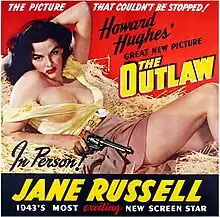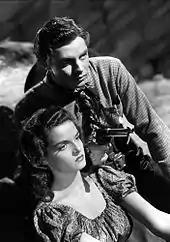The Outlaw
The Outlaw is a 1943 American Western film directed by Howard Hughes and starring Jack Buetel, Jane Russell, Thomas Mitchell and Walter Huston. Hughes also produced the film, and Howard Hawks served as an uncredited co-director. The film is notable as Russell's breakthrough role to becoming a sex symbol and Hollywood icon. Later advertising billed Russell as the sole star. The Outlaw is an early example of a psychological Western.[3]
| The Outlaw | |
|---|---|
 Theatrical Poster | |
| Directed by | Howard Hughes |
| Written by | Jules Furthman |
| Produced by | Howard Hughes |
| Starring | Jack Buetel Jane Russell Walter Huston Thomas Mitchell |
| Cinematography | Gregg Toland |
| Edited by | Wallace Grissell |
| Music by | Victor Young |
Production company | Howard Hughes Productions |
| Distributed by | RKO Radio Pictures |
Release dates |
|
Running time | 116 minutes |
| Country | United States |
| Language | English |
| Budget | $3,400,000[1] |
| Box office | $5,075,000 (est. US/Canada rentals)[2] |
Plot
Sheriff Pat Garrett welcomes his old friend Doc Holliday to Lincoln, New Mexico. Doc is looking for his stolen horse and finds it held by Billy the Kid. Despite this, the two gunfighters take a liking to each other, much to Garrett's disgust. Doc still tries to steal his horse back late that night, but Billy is waiting for him outside the barn.
After that, Billy decides to sleep in the barn, and shots are fired at him. He overpowers his ambusher, who turns out to be Rio McDonald, Doc's love interest. She is out to avenge her dead brother. It is implied that the Kid rapes Rio after ripping off her dress.[4]
The next day, a stranger offers to shoot Garrett in the back while the Kid distracts the lawman. But, he is only setting the Kid up. Billy, suspicious as always, guns down the stranger when he draws on him. There are no witnesses, and Garrett tries to arrest Billy. Garrett does not understand when Doc sides with the Kid. As the pair start to leave, Garrett shoots Billy. Doc in response shoots the gun out of his hand and also shoots and kills two of Garrett's men.
Doc flees with Billy to the home of Rio and her aunt, Guadalupe. With a posse after them, Doc rides away. Instead of killing the unconscious Kid, Rio instead nurses him to health over the next month, and even sleeps with him to keep him warm. By the time Doc returns, Rio has fallen in love with her patient, and claims to have secretly married him. Doc is furious that Billy has stolen his girlfriend. After Doc's anger subsides a bit, the Kid gives him a choice: the horse or Rio. To Billy's annoyance, Doc picks the horse. Angered that both men value the animal more than her, Rio fills their canteens with sand. The two ride off without noticing.
On the trail, they are pursued by Garrett and a posse. The pair surmise that Rio tipped the sheriff off. Doc kills a few men from long range, but leaves Garrett unharmed.
When Doc wakes one morning, he finds Billy gone and Garrett waiting to handcuff him and take him back to town. Stopping at Rio's, the two men find that Billy has left Rio tied up in sight of water in revenge. Suspecting that Billy loves Rio and will return to free her, Garrett waits. Billy indeed returns, and he is captured.
On the way back to town, they are surrounded by hostile Mescaleros. Garrett reluctantly frees his prisoners and returns their revolvers, after extracting a promise from Doc that he will give them back and make Billy do the same. They manage to elude the Indians, but Doc refuses to honor his word.
As Doc tries to leave with his horse, Billy stops him. The two men decide to have a duel, which Garrett expects Billy to lose. However, as they await the signal (the end of a clock signalling eight o'clock), Billy moves his hands away from his guns. Doc tries to provoke him, inflicting minor wounds in one hand and both ears, but the Kid still will not fire. The two reconcile. Furious, Garrett calls Doc out, despite not having a chance. Doc makes no attempt to shoot his friend and is fatally wounded. Garrett is aghast.
After Doc is buried, Garrett offers to give Billy their friend's revolvers. He also persuades Billy to give him his guns, saying that he can claim that it is Billy in the grave, and Billy can leave his past behind him and have a fresh start in life. But Garrett had removed the firing pins from Doc's revolvers. However, while comparing the guns, Billy had inadvertently switched one of Doc's for his, so neither of the men's guns fire. Billy pulls out a second, working gun. He handcuffs Garrett, judging that the lawman will say that Billy is dead rather than admit that Billy left him helpless. As he is riding away, Billy stops and looks back; Rio joins him on his horse.
Cast

- Jack Buetel as Billy the Kid
- Jane Russell as Rio McDonald
- Thomas Mitchell as Pat Garrett
- Walter Huston as Doc Holliday
- Mimi Aguglia as Guadalupe
- Joe Sawyer as Charley
- Gene Rizzi as stranger who tries to trick Billy
- Dickie Jones as boy (uncredited)
- Edward Peil Sr. as Swanson (uncredited)
- Lee Shumway as card dealer (uncredited)
Production

While filming The Outlaw, director Howard Hughes felt that the camera did not properly capture Jane Russell's bust, so he designed a cantilevered underwire bra to emphasize her figure. He added curved structural steel rods that were sewn into the brassiere under each breast cup and connected to the bra's shoulder straps. This arrangement allowed the breasts to be pushed upward and the bra shoulder straps to be moved away from the neck, exposing more of her breasts. Contrary to many later media reports, Russell did not wear the bra during filming; she said in her 1988 autobiography that it was so uncomfortable that she secretly discarded it.[5][6] She wrote that the "ridiculous" contraption hurt so much that she wore it for only a few minutes and instead wore her own bra. To prevent Hughes from noticing, Russell padded the cups with tissue and tightened the shoulder straps before returning to the set. She later said: "I never wore it in The Outlaw, and he never knew. He wasn’t going to take my clothes off to check if I had it on. I just told him I did."[7] Hughes' bra was later exhibited in a Hollywood museum.[8]
After the film was completed in February 1941, Hughes faced difficulty obtaining approval from the Hollywood Production Code Administration because of the film's display of Russell's breasts. The Code office ordered cuts, and Hughes reluctantly removed about 40 feet, or a half-minute, of footage that prominently featured Russell's bust. However, 20th Century Fox wished to cancel its agreement to release The Outlaw as a result.
Facing the loss of millions of dollars, Hughes sought to create a public outcry for his film to be banned. Hughes had his managers call ministers, women's clubs and housewives, informing them about the purportedly lewd film soon to be released. This caused the public protests and calls to ban the film for which Hughes had hoped in order to establish a demand for the film's release. As a result, the film was shown in theaters for one week in 1943 before being withdrawn for having violated the Production Code. The Outlaw was released widely on April 23, 1946, when RKO Radio Pictures premiered the film in San Francisco, where it became a box-office hit. By the end of 1946, the film had earned $3 million in domestic rentals.[9] Additional rereleases in 1950 and 1952[9] brought its lifetime rental earnings to $5.075 million.[2]
Hughes sued Classic Film Museum, Inc. and Alan J. Taylor for unlawful distribution of Hell's Angels, Scarface and The Outlaw. When it emerged that The Outlaw had fallen into the public domain in 1969 for lack of copyright renewal, the case was settled, with Classic Film Museum agreeing to stop distribution of the two copyrighted titles and Hughes withdrawing his claim on The Outlaw.[10][11]
The film was later colorized twice. The first colorization was released by Hal Roach Studios in 1988. The second colorized version, produced by Legend Films, was released to DVD on June 16, 2009, featuring both the newly colorized edition and a restored black-and-white edition of the film. The DVD version also features an audio commentary by Jane Russell and actress Terry Moore, Hughes's alleged wife. Russell approved of the colorization, stating "The color looked great. It was not too strong, like in many of the early colorized movies that made the films look cheap."
Notes
- Dietrich, Noah; Thomas, Bob (1972). Howard, The Amazing Mr. Hughes. Greenwich, Connecticut: Fawcett Publications, Inc. p. 153. ISBN 978-0449136522.
- "All Time Domestic Champs". Variety. January 6, 1960. p. 34.
- "Psychological Western". AllMovie. Retrieved January 23, 2022.
- 20/20 Movie Review of The Outlaw (1943)
- "Jane Russell". The Economist. March 12, 2011. p. 101.
- "Jane Russell". March 1, 2011. Retrieved December 30, 2011.
A joke at that time was that 'Culture is the ability to describe Jane Russell without moving your hands.'
- Tiffin, George (September 30, 2015). A Star is Born: The Moment an Actress becomes an Icon. Head of Zeus. ISBN 978-1-78185-936-0.
He wasn't going to take my clothes off to check if I had it on. I just told him I did."
- Jessica Seigel (February 13, 2004). "The Cups Runneth Over". New York Times. Retrieved October 5, 2016.
- Edgarton, Gary R. (2012). Westerns: The Essential 'Journal of Popular Film and Television' Collection. Routledge. ISBN 978-0-415-78323-1.
Some court decisions were won, others were lost, but at the end of its run, The Outlaw had managed to play 5,000 of a possible 18,000 dates and, even though some of the biggest houses had to be by-passed, it still managed to gross $3,000,000, which, by this time, was little more than Hughes' costs. Over the next few years most of this opposition evaporated – even the Legion of Decency lifted its condemnation. During 1950 and 1952, the film went through two more general releases and raised its total rental gross to over five million, making it second only to Duel in the Sun, a calculated imitation done in color, as the second biggest box office Western up to this point.
- Court case: Agreement, Summa Corporation v. Classic Film Museum, Inc., Civil Action No. 75-81 N.D. United Artists Howard Hughes Files collection, Archives Division, Texas State Library.
- Pierce, David (June 2007). "Forgotten Faces: Why Some of Our Cinema Heritage Is Part of the Public Domain". Film History: An International Journal. 19 (2): 125–43. doi:10.2979/FIL.2007.19.2.125. ISSN 0892-2160. JSTOR 25165419. OCLC 15122313. S2CID 191633078.. See note #17.
External links
- The Outlaw at the American Film Institute Catalog
- The Outlaw at the TCM Movie Database
- The Outlaw at AllMovie
- The Outlaw is available for free viewing and download at the Internet Archive
- The Outlaw at IMDb
- Advertising Blimp Archived June 8, 2021, at the Wayback Machine "Kept off the screen for 3 years, it's coming at last! The Outlaw starring Jane Russell"